Cycling: Do you check your chain wear?
Heeeyho Readers! Let's see what you do to preserve your chains!
Hooorayy! This post is more of an unboxing the unboxed. Yup. I get too excited when the mail rings the bell; before they leave I already have the boxes ripped.
I got a new chain for the mountain-bike after five-thousand kilometers (way past its lifespam). And because 12-speed parts are a hella expensive, I figured a new — more precise — chain checker would be a useful tool to have. Do you check your chain? What the hell is a chain checker?! Let's discuss.
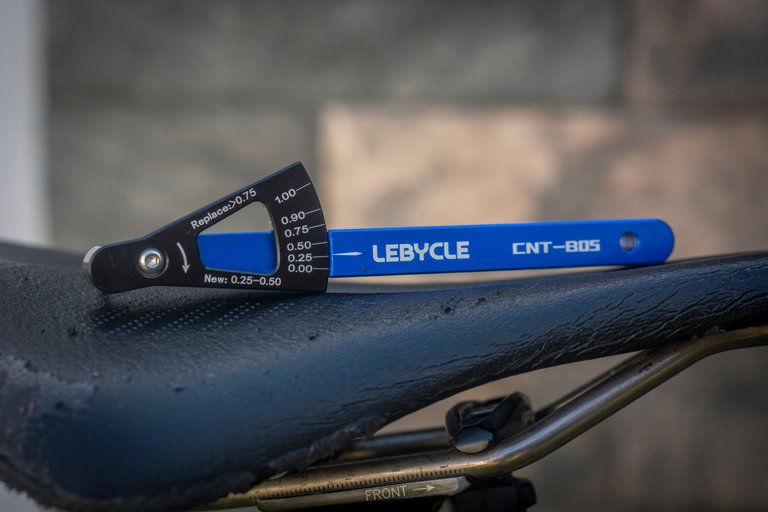
From the beginning
The chain transfers power from your legs to the back wheel through the gearing system (chanring and cassette). As any other transmission parts, chains wear out and need replecement; if not, your worn-out chain will damage the rest of the transmission system, hence the importance of checking our chain often.
During my winter trip across Europe (2018-2019), the constant muddy/snowy conditions put a lot of stress onto my bike's chain. I didn't have a checker, so was unable to track any chain wear. When I realized, my worn-out chain had stretched so much that it damaged the chainring and rear sprockets, that later also required replacement, turning a 20 usd repair into an 100 usd repair. Such hassle would've been avoided had I changed the chain a lot sooner. Get the importance of maintaining the chain in order?
Checking the chain
Now... chain checkers are incredibly cheap and easy to use. The most common are the drop-in types: They have little hooks that fit in between the chain rollers, giving us a "go" or "no-go" measurement. If the tool goes all the way in the rollers, it's time to replace. The hook type generally indicates 0.5%, 0,75% and 1% (full wear). Digital chain checkers are the most precise. Either ends of the spectrum will work to indicate us the time to replace our chains, so no need to have the top of the crop.
The chain checker I got lays in between the simplest and the digital. It has a small scale reading chain wear in .25% increments. It advises to replace the chain once the reading is above .75%.
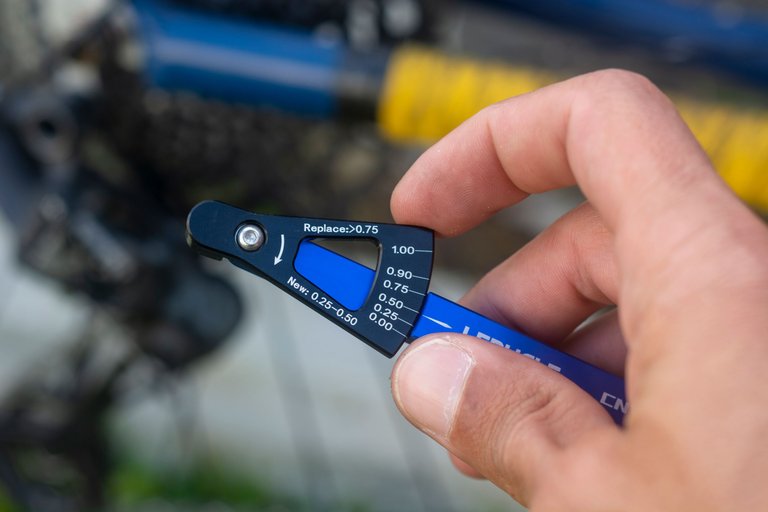
Anyone can check chain wear at home (provided you have the tool, of course). This particular checker has two pins that go in between chain rollers. Like seen below. With the scale zeroed, on a brand new chain, the pins might not even fit into the chain.
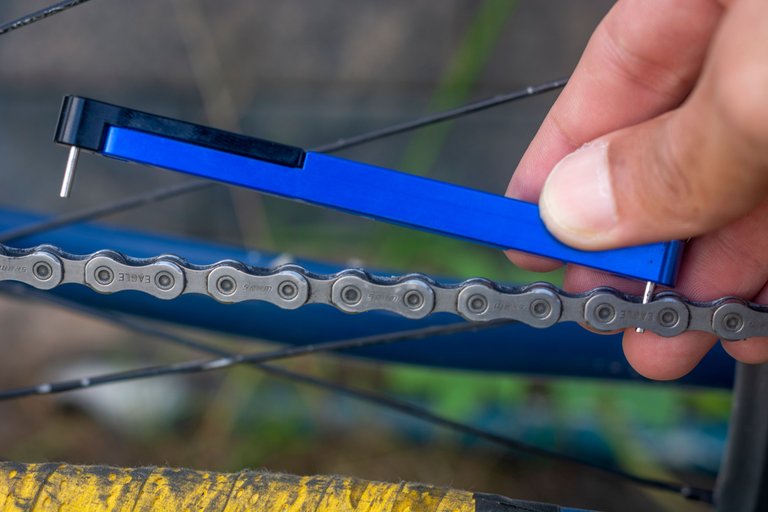
Once the pins are in between the rollers, we can slide the scale clockwise until it no longer moves. The scale (black part) moves the pin forward, which then pushes the rollers apart, that way measuring chain wear.
As you can see below, my chain reads a little less than .25%, which indicates everything is alright. That chain has ~400 kilometers of use, and I expect to reach 3.000 kilometers before reaching .75%. Will it go that far?
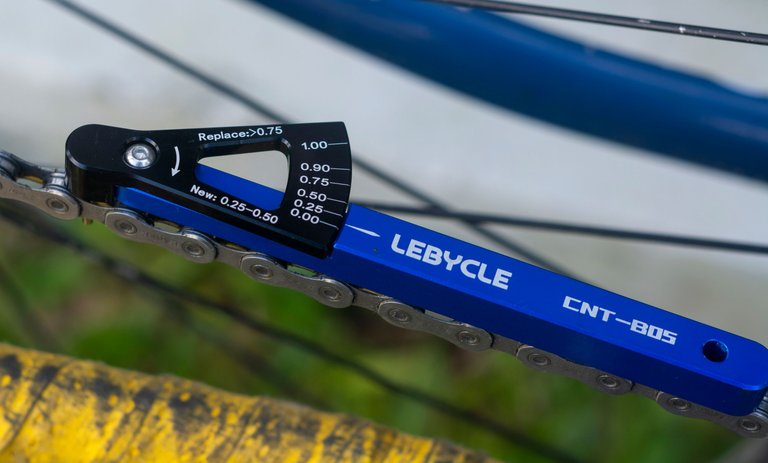
Just to exemplify, I measured my previous chain, that rode for nearly 5.000 kilometers. See the reading is almost touching the 100% mark. Using a chain for that long is incredibly harmful to the rest of our transmission system. Actually, it's quite impressive that I was not having shifting issues with such a worn-out chain.
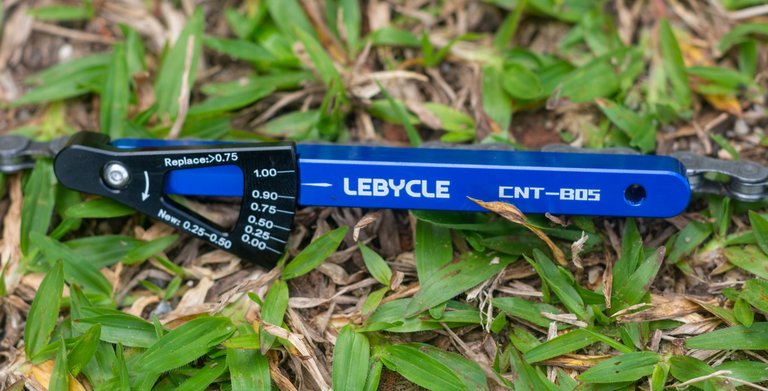
Final thoughts
We've seen the importance of maintaining our chains in order to avoid future damages to the transmission. We've also seen how to check our chain once in a while to replace it in time.
How can you get a chain checker? Most bike shops have the simple "drop-in" checker ranging between 5 - 10$. Mine costed ~5$ with a bunch of discounts on a popular Chinese marketplace. Anywhere between 5 - 20$ (more expensive brands) will perform well.
Always remember that it's cheaper on the long run to replace chains than having the entire transmission ruined.
Do you check your chain? If so, how long do they last? What kind of tool do you use?
See you next time
Peace.
If you enjoyed this post consider leaving your upvote for a hot coffee.
Find me on Twitter: https://twitter.com/mrprofessor_
~Love ya all,
Disclaimer: The author of this post is a convict broke backpacker, who has travelled more than 10.000 km hitchhiking and more than 5.000 km cycling. Following him may cause severe problems of wanderlust and inquietud. You've been warned.

@kesityu.fashion ? ;<)
Does she? Or doesn't she check her chain. Let's see xD
She definitely checks the (hive block)chain regularly ;<)
She's been busy devouring cheese somewhere on the road. Bicycle tourers are the ultimate cheese eaters
Haha! Likely.
I can relate to that.
After all, I have been born and lived 21 years in Dutch cheese city Gouda 🧀
😁 Last I heard, she was going to sleep outdoors, in nature, alone. I hope she will come and tell us about that experience. And verify her chain, of course.
I hope she remembers to check her chain before going to sleep, so she doesn't dream about squeaky chains 🤣🤣
She makes a lot of kilometers and climbs mountains, so I guess she does check her bicycle regularly. But I don't think she carries a chain checker with her on her trips. You don't want to take that much with you.
I guess she starts a new trip with a new chain.
My current thoughts are leading me straight to the necessary information about guess what? 😁 the chain... hahaha.... How often should I grease it, how often should I clean it? I saw an announcement in a WhatsApp group about this device, I didn't know what it was for, I didn't ask, but here I got the answer.
Thank you 👌
Just in time to become a chain expert xD
Chain maintenance is a huge subject, because each one os us has a way to work on them, ride in different conditions, etc etc
I, for example, use dry lube; @friendlymoose uses wet lube (i guess).
You're right! I use wet lube because I also ride in bad weather conditions.
To answer these questions; You should grease it after you have cleaned it. And how often do you have to clean it? Just have a good look at your chain. The chain must be clean. The grease should be inside the chain links. When your chain gets black and dirty of the grease it will attract sand and mud which is a sign you should clean it.
👍
Thank you!
Great post! Checking and replacing your chain can really save you money. It's not only the covered distance that counts, it's also the force you put on your chain. The more force the faster it will stretch out.
I thought I had made a post about replacing my chain a long time ago too. I'll look it up.
This post was upvoted by the Cycling Community
Subscribe to the Cycling Community and share your cycling related posts with us.
Join our Discord Channel if you want to chat about cycling.
You can support the Cycling Community by delegating HP
| 25 HP | 50 HP | 100 HP | 250 HP | 500 HP |
I found it:
https://peakd.com/hive-177745/@friendlymoose/bicycle-maintenance-replacing-your-chain
I think you did, indeed. I'll try to find all my maintenance posts so we can group them all together
Oh, great Idea!
There were some maintenance blogs of some other hivers too.
Congratulations @mrprofessor! You have completed the following achievement on the Hive blockchain And have been rewarded with New badge(s)
Your next target is to reach 8000 comments.
You can view your badges on your board and compare yourself to others in the Ranking
If you no longer want to receive notifications, reply to this comment with the word
STOPCheck out our last posts: